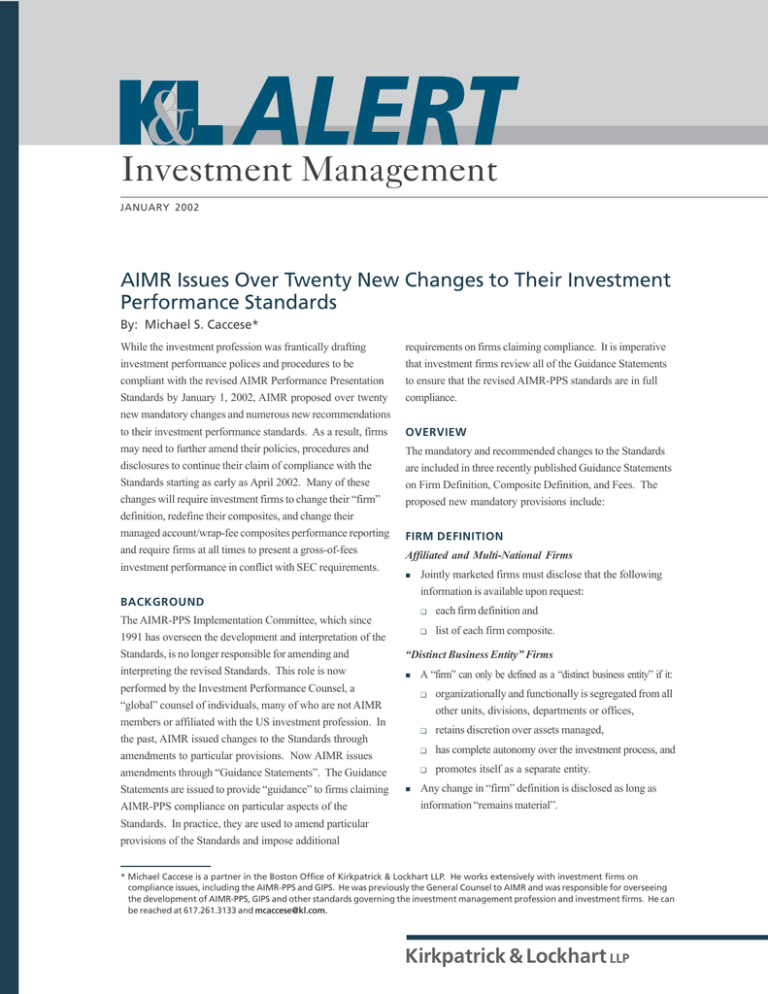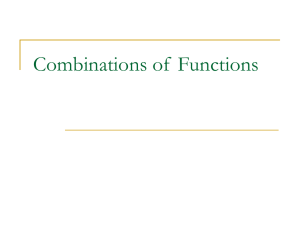
Investment Management
JANUARY 2002
AIMR Issues Over Twenty New Changes to Their Investment
Performance Standards
By: Michael S. Caccese*
While the investment profession was frantically drafting
requirements on firms claiming compliance. It is imperative
investment performance polices and procedures to be
compliant with the revised AIMR Performance Presentation
that investment firms review all of the Guidance Statements
to ensure that the revised AIMR-PPS standards are in full
Standards by January 1, 2002, AIMR proposed over twenty
new mandatory changes and numerous new recommendations
compliance.
to their investment performance standards. As a result, firms
may need to further amend their policies, procedures and
OVERVIEW
disclosures to continue their claim of compliance with the
Standards starting as early as April 2002. Many of these
changes will require investment firms to change their “firm”
definition, redefine their composites, and change their
managed account/wrap-fee composites performance reporting
and require firms at all times to present a gross-of-fees
investment performance in conflict with SEC requirements.
The mandatory and recommended changes to the Standards
are included in three recently published Guidance Statements
on Firm Definition, Composite Definition, and Fees. The
proposed new mandatory provisions include:
FIRM DEFINITION
Affiliated and Multi-National Firms
!
BACKGROUND
The AIMR-PPS Implementation Committee, which since
1991 has overseen the development and interpretation of the
Standards, is no longer responsible for amending and
interpreting the revised Standards. This role is now
Jointly marketed firms must disclose that the following
information is available upon request:
❏
each firm definition and
❏
list of each firm composite.
“Distinct Business Entity” Firms
!
A “firm” can only be defined as a “distinct business entity” if it:
performed by the Investment Performance Counsel, a
“global” counsel of individuals, many of who are not AIMR
❏
members or affiliated with the US investment profession. In
the past, AIMR issued changes to the Standards through
❏
retains discretion over assets managed,
❏
has complete autonomy over the investment process, and
❏
promotes itself as a separate entity.
other units, divisions, departments or offices,
amendments to particular provisions. Now AIMR issues
amendments through “Guidance Statements”. The Guidance
Statements are issued to provide “guidance” to firms claiming
AIMR-PPS compliance on particular aspects of the
organizationally and functionally is segregated from all
!
Any change in “firm” definition is disclosed as long as
information “remains material”.
Standards. In practice, they are used to amend particular
provisions of the Standards and impose additional
* Michael Caccese is a partner in the Boston Office of Kirkpatrick & Lockhart LLP. He works extensively with investment firms on
compliance issues, including the AIMR-PPS and GIPS. He was previously the General Counsel to AIMR and was responsible for overseeing
the development of AIMR-PPS, GIPS and other standards governing the investment management profession and investment firms. He can
be reached at 617.261.3133 and mcaccese@kl.com.
Kirkpatrick & Lockhart LLP
❏
This is the first time since the Standards were issued
Valuation
that “materiality” may be considered when complying
with the Standards.
COMPOSITE DEFINITION
!
All portfolios within a composite must have the same
beginning and ending period valuation dates.
!
The composite valuation measurement period must be
disclosed if it does not begin or end on a month end.
!
Benchmarks must be shown for same time periods
composite performance is presented.
Composite Design
!
Each composite definition (marketed and non-marketed)
must be disclosed.
!
The criteria for establishing each composite definition
FEES
must be available upon request.
Gross-of-Fees
Composites must be representative of the firm’s products
!
!
and consistent with the firm’s marketing strategy.
Composite performance must be presented gross-of–fees
but after transaction costs and non-reclaimable
!
Discontinued composites must remain on the firm’s list of
composites for at least five years.
!
Inception date cannot be used as criteria to create
Each delivery of a fully compliant presentation must
include a fee schedule applicable to the particular potential
composites (except for limited exceptions.)
client.
!
!
Minimum Asset Levels
!
withholding taxes.
Prohibition from presenting pure-gross-of-fees performance
(i.e. gross of all fees including transaction costs).
Portfolios that go below composite minimum asset level:
Wrap-Fees
❏
must remain in the composite if asset level change is a
result of market movement,
❏
must be removed if asset level change is a result of
wrap-fees.
client withdrawal, but historical performance remains.
❏
❏
Performance must be presented net-of-all “bundled”/
Portfolios removed must be analyzed for possible
inclusion in other composites.
❏
!
!
The removal of all portfolios results in composite
performance ending, historical performance remains,
Firm must disclose the services the wrap-fees cover (e.g.
custody, administration, etc.)
Sub-Advised Portfolios
and the mandatory creation of a new composite if
portfolio assets go above minimum asset level because
!
of client additions.
Sub-advised portfolios requires that the sub-adviser
performance:
❏
!
Changed composite minimum asset levels must not be
retroactively applied.
!
Firms must have policies for treatment of portfolios that
❏
add back all fees except investment management fees
for presenting net-of-fees performance, and
❏
all fees added back must be disclosed.
While the above are proposals, investment firms can
reasonable expect virtually all of these mandatory
Discretion
The following must be documented and consistently
requirements to become effective within the next several
months except for “fees” requirements, which are expected
applied across the whole “firm”:
!
add back all identifiable fees of each sub-adviser for
presenting gross-of-fees performance,
go below minimum asset levels, and document changes to
minimum asset level for each composite.
!
Requires wrap-fee composites to be presented at all
times after the deduction of all wrap-program fees.
❏
“discretion” definition,
to be effective January 1, 2005.
❏
reasons for classifying each portfolio as nondiscretionary.
Performance of non-discretionary portfolios may never be
presented to potential clients.
SM
Kirkpatrick & Lockhart LLP
Challenge us.
SM
BOSTON
●
DALLAS
●
HARRISBURG
●
LOS ANGELES
●
MIAMI
●
NEWARK
●
NEW YORK
●
PITTSBURGH
●
SAN FRANCISCO
●
WASHINGTON
.........................................................................................................................................................
This publication/newsletter is for informational purposes and does not contain or convey legal advice. The information herein
should not be used or relied upon in regard to any particular facts or circumstances without first consulting with a lawyer.
© 2002 KIRKPATRICK & LOCKHART LLP. ALL RIGHTS RESERVED.







